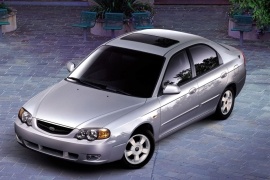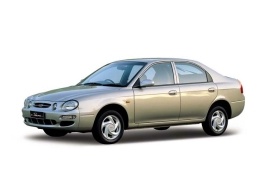KIA Shuma Models/Series Timeline, Specifications & Photos
First production year: 1998
Engines: Gasoline
In 2001, Kia added a new facelift for the Shuma's second generation and sold it in the U.S. under the Spectra name, paving the road for a new nameplate in its lineup.
The Korean automaker was on the verge of creating new models and constantly improving its lineup, and the Shuma was one of its most important vehicles to do that. It was a low-priced, well-equipped, humble sedan. It could be a commuter car and a family vehicle as well. It couldn't impress anyone with its time on the drag-strip, but it was affordable, cheap to run, and cheap to insure. But Kia understood that the "Shuma" name was not attractive enough, so it tried a different approach.
With this new facelift, the carmaker improved the front fascia, which still kept the same headlights that cut a double bubble into the bumper, similar to the styling created by BMW for its flagship model, the 7 Series. The car's profile revealed a similar three-box sedan shape, with body-colored door handles and mirrors, which surprisingly were not available on other more expensive brands. At the back, the corner-mounted taillights were tall and flanked the trunk lid, or the tailgate, depending on the version. Because the Shuma II, or Spectra, was also available with a liftback version.
Inside, the customers could find most of the features that were available for extra money on other brands. Things like air-conditioning, a tape player, and power windows were now standard on the entire range. The sunroof and the automatic gearbox, on the other hand, were offered for an extra cost.
Under the hood, Kia used a 1.6-liter gasoline engine that provided 101 hp (102 PS), and it was paired as standard with a five-speed manual. A four-speed automatic was also on the table.
In 1998, Kia introduced the second generation of the Shuma on the European market, while the U.S. received a better car named Sephia or Spectra, depending on the bodywork version.
Kia designed the platform of the Sephia's first-generation and continued its progress along with the introduction of the 1998 Shuma/Sephia lineup. The young Korean carmaker took a bolder step on the second generation and drastically changed the design and the interior. Maybe not for a better one, but nevertheless different.
Just by looking at its front, some might think of a scaled-down four-eyes Taurus, which was already on the market for two years. But the Shuma was addressed to other markets. The U.S. customers received a more conventional design approach on the Sephia, the Shuma's sibling. From its sides, the European version showed its rounded body panels and shaved edges. Its three-box design shape was slightly altered by a wider C-pillar and the tall, short trunk.
The interior was quite interesting for the Korean carmaker. Its rounded shapes of the dashboard resembled those installed on the Ford Contour/Mondeo, with the driver surrounded by the instrument cluster and the center stack. Kia used to work with Mitsubishi and was inspired by its rounded buttons for the climate control, but placed them lower, harder to reach by the driver. In the back, the car offered just enough room for two passengers, while three were already too many.
Under the hood, Kia used a licensed-built Mazda engine and its own 1.8-liter unit. Both were paired to a standard five-speed manual.

